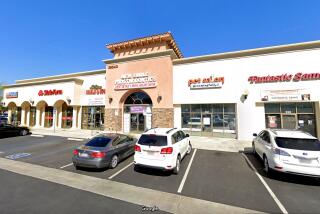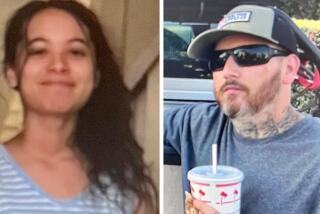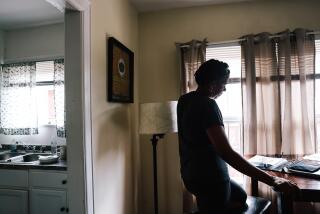Video in fatal North Charleston, S.C., police shooting sets case apart
- Share via
Reporting from NORTH CHARLESTON, S.C. — The family gathered for an impromptu memorial on the grass where Walter L. Scott had been shot to death by a white police officer the day before. They were still in shock, unable to accept police accounts that Scott had struggled with the officer over his Taser.
As they mourned, a stranger approached Anthony Scott, the victim’s brother. “I have something to share with you,” the young man told him.
He held out a Samsung cellphone.
On the screen, Scott, 52, watched a shaky video of his younger brother running away, unarmed, as an officer shot eight times at his back. Walter, 50, fell next to a tree and was handcuffed as he died.
“Oh my God,” Scott said.
For decades, African Americans, including those in North Charleston, have complained that police shoot black men with little provocation and then falsely claim the officers did so out of fear for their lives.
This time there was video.
“The officer lied in his incident report and his lies were corroborated by the Police Department,” said Justin Bamberg, an attorney representing the Scott family. “It wasn’t until the video came out that all that changed completely.”
As the nation has struggled to reckon with a string of controversial police shootings in recent months, the now-viral video of Scott’s shooting offers a rare bit of clarity.
Many of the previous cases had varying degrees of ambiguity — a toy gun, conflicting witness statements, chaotic video — that allowed debate to sharply divide along cultural fault lines and let possibly guilty officers go unpunished.
But state investigators received the video of Scott’s shooting late Monday, and Patrolman Michael T. Slager, a five-year veteran of the force, was arrested and charged with murder the next day. He was fired Tuesday night.
The swift action differs sharply from the aftermath of controversial shootings in Ferguson, Mo., Cleveland, Albuquerque and Los Angeles, and a fatal chokehold by an officer in New York.
“I have watched the video and I was sickened by what I saw,” Eddie Driggers, the North Charleston police chief, said at a news conference. “And I have not watched it since.”
North Charleston Mayor Keith Summey, speaking at a news conference Wednesday that was often interrupted by protesters, called the shooting a tragedy for both families — the white officer’s and the slain black man’s. The city will continue to pay health insurance for the officer’s wife, who is eight months pregnant, he said.
“This has been a horrible tragedy within our community,” said Summey, who had prayed earlier with the Scott family.
The police officer’s attorney issued a short statement Wednesday saying that he had just begun to look into the circumstances of the shooting.
“As we focus in on the facts, we will probably have more to say, but it is far too early for us to be saying what we think,” said Andrew Savage, a former prosecutor with the South Carolina Attorney General’s Office who will serve as Slager’s lead counsel.
Like Ferguson, where the shooting of an unarmed black man in August prompted months of protests across the country, North Charleston, population 104,054, is racially mixed — 47.2% black and 41.6% white — while the Police Department is about 18% black.
But unlike in Ferguson and some other cities, demonstrations have been peaceful, even though there has been long-standing tension between the black community and the police.
Civil rights leaders attributed the relative calm to the quick decision by local prosecutors to charge Slager.
“Because the truth came out early, it’s been fairly quiet,” said Edward Bryant III, president of the North Charleston NAACP. “It’s only when the truth stays hidden that you get violence.”
Anthony Scott said he wanted to see the justice system convict Slager of killing his brother but did not want violent protests.
“I hope there will be no confrontations, and that people don’t take this in that direction,” he said.
The Justice Department and the FBI are assisting state authorities in the investigation and prosecution.
Scott was pulled over for a broken tail light Saturday morning as he approached an Advance Auto Parts store, where he was seeking parts for a 1990 silver Mercedes-Benz he had bought earlier in the week.
A father of four, he phoned his mother as he was being stopped. “Mom, I’m being pulled over,” his brother recalled him saying. That was the last time the family spoke with him.
Walter was wary about driving in the neighborhood, his brother said.
“In that area,” Anthony Scott said, “they will pull you over for anything. You have to be cautious in North Charleston. It doesn’t matter what race you are.”
Walter told his brother several times that he feared being stopped by the police because there was an outstanding warrant for him for failure to pay child support.
“I think that’s why he ran … rather than be confrontational,” Anthony Scott said. “He thought, ‘Let me get out of here.’”
Feidin Santana, the man who filmed the shooting, told NBC on Tuesday that he saw Slager and Scott engaged in a physical struggle on the ground before he began recording the incident.
Slager was on top of Scott while the two wrestled on the ground, according to Santana, who said the officer “had control of the situation.” As Scott stood up to run away, Santana said, he could hear the buzz of Slager’s stun gun.
Walking along a low chain link fence, the bystander focused his phone on the two just as Scott appeared to break away from the officer. A small object is flung behind them, and Scott appears in the video to be connected to the wires of a stun gun.
Within two seconds, the officer takes aim with his handgun and fires. Eight shots sound off before Scott falls face down about 30 feet away.
After opening fire, Slager spoke into his police radio: “Shots fired and the subject is down. He took my Taser,” according to police reports.
The video shows Slager walking to Scott, who is lying prone, and handcuffing him, then walking back to the area where the object was flung. He leans down as if to pick an item up, then returns to Scott and drops something.
Scott’s family, their attorney and the president of the National Assn. for the Advancement of Colored People chapter believe the object is the stun gun, placed to appear as if Scott had it in his hands.
An autopsy found that Scott was shot five times — four times in the back and one shot that grazed his ear, according to Bamberg. He says the family plans to sue the city and Police Department for Scott’s shooting.
Scott’s mother, Judy Scott, 73, said she couldn’t bear to watch the whole video. “I saw my son running and I didn’t want to watch any more,” she said.
“I have never been through this before, and I pray other mothers and families don’t have to go through this,” she said. “I have heard of others, but when it hits home — oh.”
Watching the video Wednesday, retired Los Angeles County sheriff’s Cmdr. Charles “Sid” Heal said he couldn’t see any way the killing was justified.
“The man basically is running and never even turns to look. He isn’t zig-zagging. He is just running and he’s shot several times in the back,” said Heal, who has testified in dozens of officer force cases. “Only with wildest of imagination can I contrive a set of facts that would explain it.”
This city’s black population has complained for years that the largely white Police Department uses excessive force, according to local civil rights leaders.
Before Scott’s death, lawyers for victims’ families and civil rights leaders had accused police on several occasions of wrongfully shooting black suspects.
“This incident fits a pattern of abuse that has gone on for years,” said Bryant of the NAACP. Bryant says he suspects police of regularly planting or covering up evidence. “This is standard practice in this Police Department,” he said. “There is a code of conduct to cover their behinds. We call it Code Blue.”
The head of the American Civil Liberties Union in South Carolina said Scott’s death should raise larger questions about police in North Charleston, where residents have often said police make unnecessary traffic stops that are tantamount to racial profiling.
“We think that this should not be regarded as a one-time incident, a one-off shooting by a rogue officer,” said Victoria Middleton, executive director for the ACLU in South Carolina. “It’s critically important that serious questions be asked about police methods.”
Twitter: @davidzucchino
Twitter: @JamesQueallyLAT
Twitter: @joemozingo
Zucchino reported from North Charleston and Queally and Mozingo from Los Angeles. Times staff writers Timothy M. Phelps in Washington and Christine Mai-Duc, Michael Muskal, Matt Pearce and Richard Winton in Los Angeles contributed to this report.
More to Read
Sign up for Essential California
The most important California stories and recommendations in your inbox every morning.
You may occasionally receive promotional content from the Los Angeles Times.













